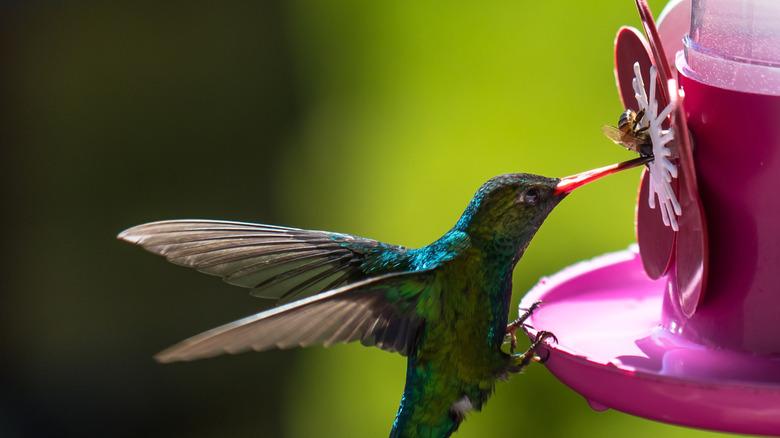Pollinator-Friendly Plants That Will Keep Bees Away From Your Hummingbird Feeder
We may receive a commission on purchases made from links.
Watching a hummingbird hover in place to sip nectar from your feeder is a gratifying experience. Small but surprisingly sturdy, hummingbirds are pollinators of the first order. We more often think of insects like bees when we consider pollinators. And, perhaps there's no better proof of that than seeing bees at our hummingbird feeders competing for the sugar water "nectar." Most of us would prefer that the bees find their own nectar from flowers and other plants, and leave the hummingbird feeder for, well, the hummingbirds. The good news is that by planting certain pollinator-friendly flowers and shrubs, especially ones that are yellow, we can draw the bees away from the feeder.
One key piece of information for you to know is that, while bees have very good eyesight, they can't see the color red. On the other hand, they seem to be especially attracted to the golden-yellow shades of plants in the garden. One good step to take would be to make sure your hummingbird feeder doesn't have any yellow in it. Hummingbirds can see all the colors, and even some that we can't see, but they are primarily attracted to the color red.
Plant these stunning yellow flowers to keep bees preoccupied
Two yellow flowers that are proven to attract bees are black-eyed susans and sunflowers. They complement one another, as black-eyed susans bloom early in the year and sunflowers tend to bloom later, providing an extended time period for the bees. When you grow sunflowers, many insects can take advantage of its nectar at one time due to their size.
While it's true that bees are very attracted to the color yellow, they also love bee balm ... as the name would indicate. Bee balm attracts all types of pollinators, but bees especially. Zinnias are another flower that will please the bees, because they'll keep on blooming all summer long. For that same reason, goldenrod is a great plant to draw bees from your feeders. It is a late bloomer and stretches deep into the fall. Be assured that all of these plants help pollinators do their job.
While flower will certainly help you keep bees away from your hummingbird feeder, there are many flowering shrubs that will do the trick as well. The ubiquitous lilac is an excellent example, as are dogwoods with their white or pink flowers. Depending on where you live, plants like lavender (you can even grow lavender in a pot), spirea, fuchsia, and hydrangea should be on your radar. The lovely advantage to these shrubs is that they will flower year after year with little work for you.
More considerations regarding bees and hummingbird feeders
It needs to be said that even with exceptional effort, it will be impossible to keep every bee away from your hummingbird feeder. The positive news in that regard is that bees almost never hurt hummingbirds. Cleaning your feeder regularly will help make it less interesting to bees. If some bees show up, move the feeder. Hummingbirds can see red and are motivated to search out a feeder that has moved, whereas bees are more easily discouraged.
Another tactic is to change the sugar solution you are making, as bees tend to prefer sweeter nectar than hummingbirds do. The most common formula is 1 cup of sugar to 4 cups of water. Change that ratio to 5 cups water to 1 cup sugar and see how that works. You can try adding these HummZinger nectar guard tips to your feeder to deter the buzzing insects as well.
Planting flowers and shrubs that attract and support pollinators is an effort that you can be proud of. You not only get a beautiful garden out of it, but you are supporting pollinators that are critical to human survival. And, if these plantings keep bees from hogging all the sugar water you are making for your hummingbird feeders, that is even better!


